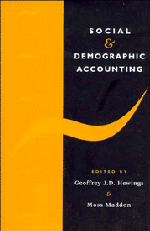Book contents
- Frontmatter
- Contents
- List of contributors
- 1 Social accounting: essays in honour of Sir Richard Stone
- 2 A SAM for Europe: social accounts at the regional level revisited
- 3 Interregional SAMs and capital accounts
- 4 Social accounting matrices and income distribution analysis in Kenya
- 5 Structure of the Bangladesh interregional social accounting system: a comparison of alternative decompositions
- 6 Decompositions of regional input–output tables
- 7 Consistency in regional demo-economic models: the case of the northern Netherlands
- 8 A CGE solution to the household rigidity problem in extended input–output models
- 9 Operationalising a rural–urban general equilibrium model using a bi-regional SAM
- 10 Combatting demographic innumeracy with social accounting principles: heterogeneity, selection, and the dynamics of interdependent populations
- 11 A micro-simulation approach to demographic and social accounting
- Bibliography
- Index
11 - A micro-simulation approach to demographic and social accounting
Published online by Cambridge University Press: 10 October 2009
- Frontmatter
- Contents
- List of contributors
- 1 Social accounting: essays in honour of Sir Richard Stone
- 2 A SAM for Europe: social accounts at the regional level revisited
- 3 Interregional SAMs and capital accounts
- 4 Social accounting matrices and income distribution analysis in Kenya
- 5 Structure of the Bangladesh interregional social accounting system: a comparison of alternative decompositions
- 6 Decompositions of regional input–output tables
- 7 Consistency in regional demo-economic models: the case of the northern Netherlands
- 8 A CGE solution to the household rigidity problem in extended input–output models
- 9 Operationalising a rural–urban general equilibrium model using a bi-regional SAM
- 10 Combatting demographic innumeracy with social accounting principles: heterogeneity, selection, and the dynamics of interdependent populations
- 11 A micro-simulation approach to demographic and social accounting
- Bibliography
- Index
Summary
Introduction
In this chapter the problems of demographic and social accounting are addressed from an alternative perspective–that of micro-level analysis. We attempt to both review and describe how this alternative approach can be used to address some of the many and diverse problems that Richard Stone was concerned with during his long and distinguished academic career.
The attractions of accounts-based approaches are now well understood, particularly in the areas of economic modelling, especially in input–output analysis, and in population projection work. It is interesting to note that the theoretical and practical consistencies afforded by an accounts-based framework have been exploited by regional scientists adopting a mathematical as opposed to statistical modelling approach. The latter approach, however, has proved to be consistently more popular than the former, largely through the relative ease of model implementation as a result of widely available computer software (Clarke and Openshaw, 1987). Many enthusiastic users of these packages would do well to examine the accounting consistencies of their models before drawing too many conclusions from their results. Rogers, in chapter 10 of this volume, addresses some of the problems of consistency that can arise in implementing models without paying careful attention to the coefficients that these models include. Mathematical models with underpinning sets of accounts have inherent advantages over statistical methods despite the operational difficulties that can be encountered.
- Type
- Chapter
- Information
- Social and Demographic Accounting , pp. 195 - 221Publisher: Cambridge University PressPrint publication year: 1995

